Exploring the mysteries of Cuba’s coral reefs
Lessons that scientists learn here could help them safeguard other such ‘animal forests'
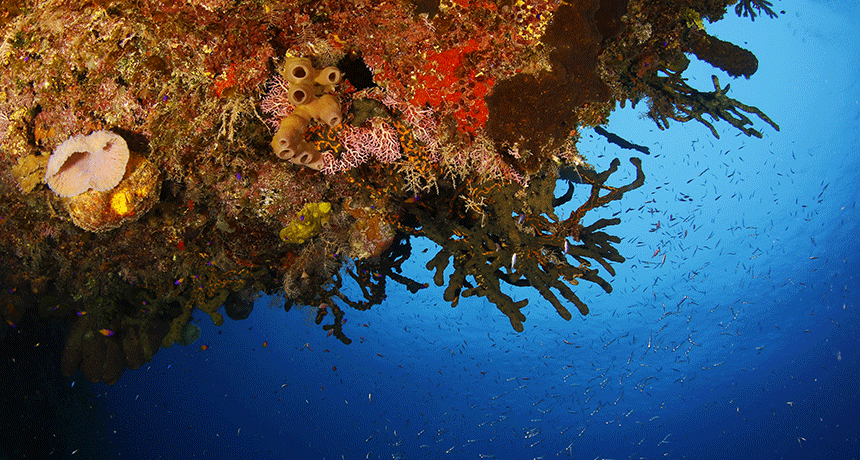
A colorful coral reef in Cuba provides housing for numerous creatures, as well as refuge for young fish, such as the silvery ones schooling in the background.
Courtesy of Noel López Fernández
By Bryn Nelson
PLAYA LARGA, Cuba — The Bay of Pigs is surprisingly clear and vividly blue — nothing like its name might suggest. Cuba’s famous bay looks like an artist’s palette — one that stretches toward the horizon. There’s a streak of robin’s-egg blue by the rocky shore. Further out, the water turns turquoise, then navy blue where the seafloor drops down to meet the deeper ocean.
Beneath the surface, bright bursts of other colors come into view. Even in 10 meters (about 33 feet) of water, you can see hills on the sandy bottom. Look closer and you can see that each hill is a clump of fanciful structures in greens, browns, oranges and purples. They resemble piles of boulders topped by tubes, antlers, bushes and fans. They’re coral reefs, or stony ridges made from the external skeletons of millions of tiny marine creatures living together. Fittingly, some scientists call them “animal forests.”
Many of these animal forests around the world are in big trouble. People have harmed some by carelessly climbing on the corals or by catching too many of the fish that keep reefs healthy. Diseases, global warming and fierce storms have battered other reefs. Scientists are especially worried about Australia’s Great Barrier Reef. Unusually warm water there in 2016 killed large sections of the connected corals.
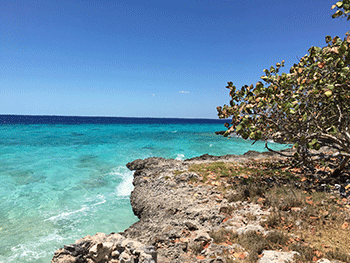
Recent research suggests that pollution and warmer waters have raised the risk of mass die-offs in other tropical reefs. Such threats can leave huge dead zones in the water and turn corals a ghostly white. One recent study found that corals off the coast of Panama had been badly damaged within the past decade.
Other researchers have been noting more gradual changes that have taken place over centuries. To do this, they pored over old sailing charts. These charts had warned sailors about the locations of reefs to help prevent shipwrecks.
Looking at those charts now suggests that the island chain making up the Florida Keys has lost more than half of its corals during the past 240 years. Reefs closest to shore have suffered most.
Most Cuban corals have avoided the same fate. Scientists now want to know why.
Some reefs near Cuba’s coast, like those in the Bay of Pigs, have lost large predators, such as sharks and sea turtles. Even so, they still support communities teeming with colorful medium-sized and smaller fish. Coral hills, called patch reefs, grow closer together. They can rise up to become low mountains. Then they disappear into deepest blue down the ledge.
The United States and Cuba have a troubled past that can be traced in part to this very bay on the island’s southern coast. And their prickly relationship has often made it hard for the two countries’ scientists to work together.
In 1961, about 1,400 exiled Cuban soldiers returned to the Bay of Pigs and tried to invade the country. With support from the United States, they tried to overthrow a new ruler named Fidel Castro. He was a rebel who had seized power and was setting up a form of government known as communism.
The invasion failed. Castro stayed in power. And the United States and Cuba have been at odds ever since.
Relations between the two countries have warmed a bit over the past few years. Despite ongoing disagreements and travel restrictions, Cuba’s wide variety of unique wildlife is drawing more U.S. scientists and tourists. The World Wildlife Fund has called this nation“by far the most biologically rich and diverse island in the Caribbean.” Researchers from both countries now are teaming up on new projects. And they’re calling for more cooperation to help Cuba preserve its unusually healthy corals.
By working together, the researchers hope to shed new light on important species that live on or near the reefs. What they learn could help scientists protect other ocean animals around the world.
Doing the time warp
Compared to coral reefs elsewhere in the Caribbean Sea, many of Cuba’s are “quite stunning,” says Daria Siciliano. She’s a coral expert at the University of California, Santa Cruz. These reefs, she says, host more species and in greater numbers. They also are virtually undisturbed by humans.
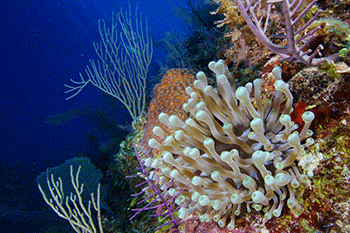
“In Cuba, you can very much see some of the coral reefs that you would have seen 50 years ago elsewhere,” Siciliano says. “So it’s a time warp.”
Coral reefs do better when they have plenty of fish in all sizes. Cuba’s reefs have fared well because many still have small and large species that other places have lost.
Dan Whittle directs the Cuba Program at the nonprofit Environmental Defense Fund in Washington, D.C. He explains that larger animals, such as sharks and other big fish, eat smaller ones. This helps maintain a healthy balance between predators and prey.
The reefs, in turn, are a key link in a chain of connected habitats that includes coastal swamps and the deeper ocean. Neighboring the Bay of Pigs is Cuba’s Zapata Swamp. Some biologists consider it the most important wetland in the Caribbean. Eighty percent of Cuba’s species can be found here, including the critically endangered Cuban crocodile.
To the east, scuba divers and researchers love exploring another underwater wonderland. It’s called Gardens of the Queen National Park and is about 90 kilometers (56 miles) off of Cuba’s southeastern shore. Coral reefs there are so pristine that some visitors have nicknamed it “The Crown Jewel of the Caribbean.”
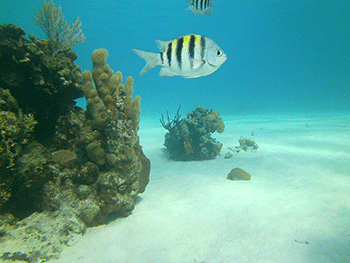
One potential reason for the Cuban reefs’ good health is that the country has less pollution than in neighboring countries. Cuban farmers use fewer chemicals on their fields that can wash into the ocean when it rains. Cuba also hasn’t built as many homes and businesses along its coastline as many other nations have. In all, the country has protected about 23 percent of the shallow ocean waters surrounding the island. (A total fishing ban in some of those areas helps protect fish of all sizes. It also keeps the number of predators and prey in balance.) About 3 percent of U.S. waters are in comparable protected zones.
Cuba’s conservation record isn’t perfect. And plenty of challenges remain. Enforcing rules to protect the environment can be especially hard in a poor country. “You have to take into consideration that there are priorities for Cuba. And one of those priorities for the Cuban government is providing food,” observes Jorge Angulo-Valdés. He’s a marine biologist and conservationist in Cuba at the University of Havana.
The country’s recent surge of tourists may bring more pollution and damage to the reefs. But researchers hope the more tourists coming to see Cuba’s wildlife will convince more people to protect that environment.
Angulo-Valdés says Gardens of the Queen shows how tourism can provide jobs. The national park draws scuba divers from around the world who want to experience its natural beauty. Those divers need tour guides, food and places to stay. Protecting nature, in other words, can pay off.
And new research is showing which ocean animals may need the most help.
Puppies of the sea
In the underwater forests of Gardens of the Queen, divers can swim among stingrays and a half-dozen shark species. One of the national park’s most popular residents, though, is the goliath grouper. “It’s like a small car,” says Fabián Pina Amargós. He’s the park’s chief scientist.
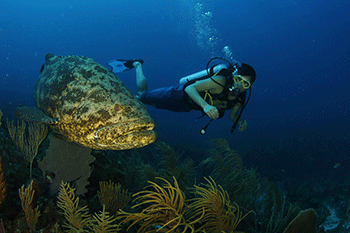
To study the grouper, he and other scientists attached tags to four of them in 2001. The groupers were so friendly and unafraid that they swam right up to the researchers. Some divers have likened the intensely curious fish to giant puppies. Pina Amargós says fishers later caught all four of the tagged groupers. The fish had swum beyond the park’s boundaries, where it was legal to catch them.
The International Union for the Conservation of Nature considers goliath groupers to be critically endangered. That means they are at high risk of going extinct. In order to save this species, researchers will need to understand it better.
Pina Amargós and U.S. collaborators are now studying where this species goes to reproduce, or spawn. Scientists have found other spawning sites in Florida and elsewhere in the Caribbean. Spawning is the most critical part of the goliath grouper’s life cycle, Pina Amargós says. It’s when these fish gather together, making them at highest risk of being captured.
Pina Amargós and other scientists believe the goliath grouper plays an important role in Cuba’s coral reefs. Researchers know that groupers feed on lobster and small and medium-sized fish — even turtles. Some startled fishers even shot a video of a goliath grouper devouring a young shark. So far, though, scientists know little else about how this species interacts with its neighbors.
Mangrove trees look like they’re half underwater. They line murky, iced tea-colored waterways, like those in Zapata Swamp. Young goliath groupers use the swamps as nurseries. Here, the growing fish can hide in the shade of low-hanging branches and within the twisted roots of the mangroves.
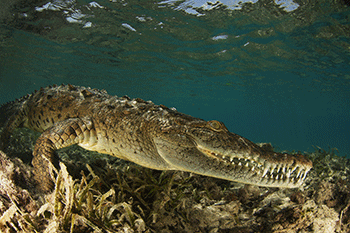
Because unprotected mangrove forests are accessible to fishers, however, the groupers can be caught easily “They aren’t afraid of anything,” Pina Amargós explains. “They are very curious. If you make any noise, they will go to see what’s going on. They are a very easy target.”
Some tourists want to visit the swamp to see rare birds or the Cuban crocodile, found only in Cuba. Others want to see the reefs and Cuba’s groupers, sharks and other creatures. So Angulo-Valdés, Pina Amargós and other scientists are training fishers, divers and tour guides how to collect important information. Knowing which animals have been seen or caught could help them protect the most vulnerable ones.
A star (coral) is born
Scientists are taking a closer look at corals themselves for important clues about the health of reef ecosystems. This intricate network includes the animals and the spaces where they live and interact. If you look closely in the Bay of Pigs, you can see crevices in the coral filled with tentacle-covered creatures. They almost look like tiny jellyfish.
These coral polyps are the architects of the eye-catching structures that make up coral reefs. Much like clams, the soft polyps protect themselves from predators by constructing strong external skeletons. Over time, their skeletons fuse together to create vast apartment complexes. The coral creatures build their fortified homes from a mineral called calcium carbonate. It’s the same mineral that forms clamshells and limestone.
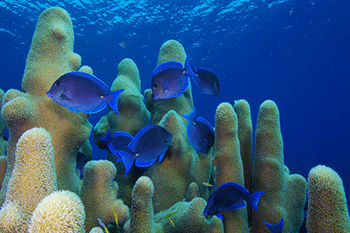
Corals grow slowly. They add a thin layer of limestone every year and communities can live for centuries. Their underwater cities, in turn, provide the foundations and shelters that other living things need to grow.
Corals are animals, but their hard reefs are similar to trees in that they can store information about environmental conditions. Reefs can record how cold and salty the water is, for example. They also can reveal whether certain forms of pollution and fertilizer have washed into the sea. Corals do so by trapping tiny bits of water-borne chemicals within their homes’ limestone layers. In this way, each layer resembles a tree ring.
Siciliano has worked with Cuban and U.S. scientists to study the health of Cuba’s coral reefs. In 2015, they used a drill to remove a long coral sample from a species called a massive starlet coral. This time capsule includes more than 200 years of history. It dates back to the late 1700s. Siciliano thinks the boulder-like coral they sampled may be even older.
Through her research, Siciliano hopes to understand the past and present health of these corals. She and other scientists agree that global warming is one growing threat.
Tiny algae that live inside each polyp use sunlight to create nutrients. These photosynthetic algae, as they’re known, normally supply the coral animals with food and distinctive colors. If the water gets too warm (or too cold), though, the algae can produce toxins that make the polyps sick. If they get too sick, the polyps may evict the algae. But in so doing, the corals lose their food supply. They can turn pure white, which is why researchers say they’ve been “bleached.” If the algae stay away and the bleaching process lasts too long, the corals will die.
Mystery of the urchins
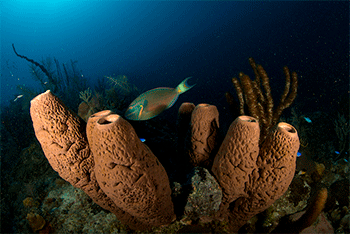
Scientists say many coral reefs in Cuba seem better able to withstand bleaching than corals elsewhere. Patricia González Díaz says Cuban corals’ abundant food may help explain this. González Díaz directs the Center for Marine Research at the University of Havana and is an expert on coral reefs. Reef health may depend in part on two strange-looking sea creatures. One, a black sea urchin, resembles a small ball studded with long black spikes. Another, called a parrotfish, looks like it has been dipped in rainbow-colored paints.
These animals are important because they help corals win a tug-of-war over growing space with other types of algae that are competitors. Some green algae, brown algae and other sea life can grow like turf or weeds. They may smother underwater surfaces. When the algae have good growing conditions and plentiful food, González Díaz says, “they win the competition with corals.” Pollution that flows into the ocean, for example, can act as a fertilizer to help the algae grow.
She and other researchers believe this may be happening near Havana, Cuba’s capital. In reefs by the polluted but slowly recovering Havana Bay, algae grow thick while the corals are small and spread out.
Black sea urchins, parrotfish and other species graze on the algae. These herbivores, or “plant eaters,” are like underwater goats and cows that keep algae under control. In 1983 and 1984, however, black sea urchins throughout the Caribbean died without warning from a mysterious disease. Without them, the parrotfish and other herbivores couldn’t eat algae fast enough. The algae began smothering some of the reefs and pushing out the corals. This stress made the remaining corals less healthy.

Recently, though, black sea urchins have begun returning to the Bay of Pigs and elsewhere. Scientists hope they might help corals regain their footing in the tug-of-war with algae. In April 2017, dozens of the spiky black creatures clung to nooks near the shore of a popular snorkeling spot. González Díaz says researchers don’t yet understand why the urchins have returned to some places but not others. Studies underway may help her and her colleagues learn how and where the black sea urchins are spreading.
Unlocking the mysteries of Cuba’s coral reefs will take time, money and cooperation. Cuban researchers hope to learn from scientists in the United States about what has worked and what hasn’t. In return, Cuban scientists say, their country’s waters could serve as natural labs. More research there could help scientists learn how to best protect ocean species — in Cuba and elsewhere.
“Science can really make the strongest justification for keeping the door open between our two countries,” Whittle says. After all, the United States and Cuba are just 145 kilometers (90 miles) apart, joined by the same expanse of blue. Whatever helps the many animals in the Bay of Pigs and Gardens of the Queen could help those in U.S. waters too.
Despite the past, Angulo-Valdés says the common goal of protecting coral reefs could yet bring the neighbors even closer together.
Goliath Grouper Aggregation – M/V Castor from John Casey on Vimeo.







